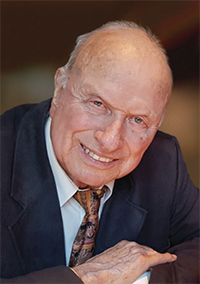In Memoriam: Walter A. Müller
1931-2018
by Arne Luz and Roland R. Wick

Dr. Walter A. Müller passed away on 18 December 2018. He was born in Ludwigshafen, Germany, on 30 September 1931, the son of Dr. Rudolf Müller, a chemist at BASF. After graduating from high school in Heidelberg in 1951, for three semesters he studied music—a passion that accompanied him throughout his life—before moving on to physics in 1953. After taking his diploma in Göttingen in 1955, he enrolled at the University of Vienna, where he completed his physics studies in 1959 with a doctoral thesis. The subject of his dissertation was already very relevant to the environment at that time: "On the radioactivity of fission products in samples of atmospheric aerosol from the period April–December 1958 (translated from German)". This work on the so-called "hot particles" resulting from atmospheric atomic bomb experiments, which were disseminated worldwide via the jet stream, provided early evidence for the resulting environmental pollution.
This work drew the attention of the radiation biologist Otto Hug (1913–1978) (a postgraduate of the well-known German biophysicist and radiation researcher Boris Rajewsky) who worked for the International Atomic Energy Agency. After his appointment as chair of radiation biology at the University of Munich, Hug hired him to work in Neuherberg at the Nuclear Research Center Karlsruhe. So Müller was one of the founding members of the Gesellschaft für Strahlenforschung, the later GSF National Research Center for Environment and Health Neuherberg (now Helmholtz Center Munich). In his competence for measuring radioactivity, he had already published in 1967 a much-noted paper in Nature on the gonad dose in male mice after incorporation of strontium-90, which is essentially based on the accumulation of its daughter nuclide yttrium-90 in the testis.
In summer 1970, Müller had an interchange of ideas with the physicist Charles W. ("Chuck") Mays and the pathologists Agnar Nilsson and Arne Luz (with the latter he subsequently authored numerous publications forming the basis for his findings on the risk of fractional administration of radionuclides). This meeting led to the plan to systematically examine the tumor risk after the incorporation of radium-224 (224Ra) using different fractionation schemes. In contrast to a single dose of 224Ra, corresponding to a skeletal dose of approximately 10 Gy, which led to a bone-tumor frequency of less than 10%, a bone-tumor frequency of more than 90% was found when administered in 72 fractions (at intervals of the half-life of approximately three and a half days) over a period of 36 weeks. This effect could not be explained by the mere prolongation (the so-called "protraction effect"—published in Radiation Research in 1974) of the internal irradiation time. Rather, this fractional incorporation of 224Ra (in which the total radiation dose is deposited at the bone surface due to the half-life of 3.66 d) was a model for risk assessment after incorporation of the long-lived plutonium-239 (which remains at the bone surface for a lifetime).
In 1974, Müller, as a visiting scientist at the French nuclear research center in Fontenay-aux-Roses, was able to prove in experiments following inhalation of thorium-227 that there was also a considerable burden to the bone (more than one fifth of the lung dose). In the following years, the time-factor studies were extended to beta emitters too. The fractionation of the short-lived lutetium-177 also led to a significant increase in bone-tumor risk. At his suggestion in another time-factor experiment with 224Ra, the fractionation effect was studied at a very small dose level (0.15 Gy) with 72 fractions over 36 weeks. Starting during the incorporation period, more than 10% of the animals developed malignant lymphoma instead. This surprising observation was due to the research spirit of the experimental physicist Müller, who did not want to rely on theoretical estimates. With regard to the amount of radionuclides, the risk of bone tumors after systemic radionuclide incorporation was many times higher than from the same amount of radionuclides after local deposition adjacent to the bone. He presented many of his findings in nearly 100 publications, including Health Physics (1971, 1978, 1983, 1988, 1990). Also worth mentioning is the long-standing friendship and scientific cooperation with Chuck Mays until the latter's premature death in 1989.
It remains the memory of an outstanding research personality with original and far-sighted ideas, an exceptional and amicable person who shared his musical talent (he played the piano enthusiastically all his life and even received an award for a piano sonata composed by him in his youth) with his colleagues and delighted them beyond his research. We will miss him very much.



